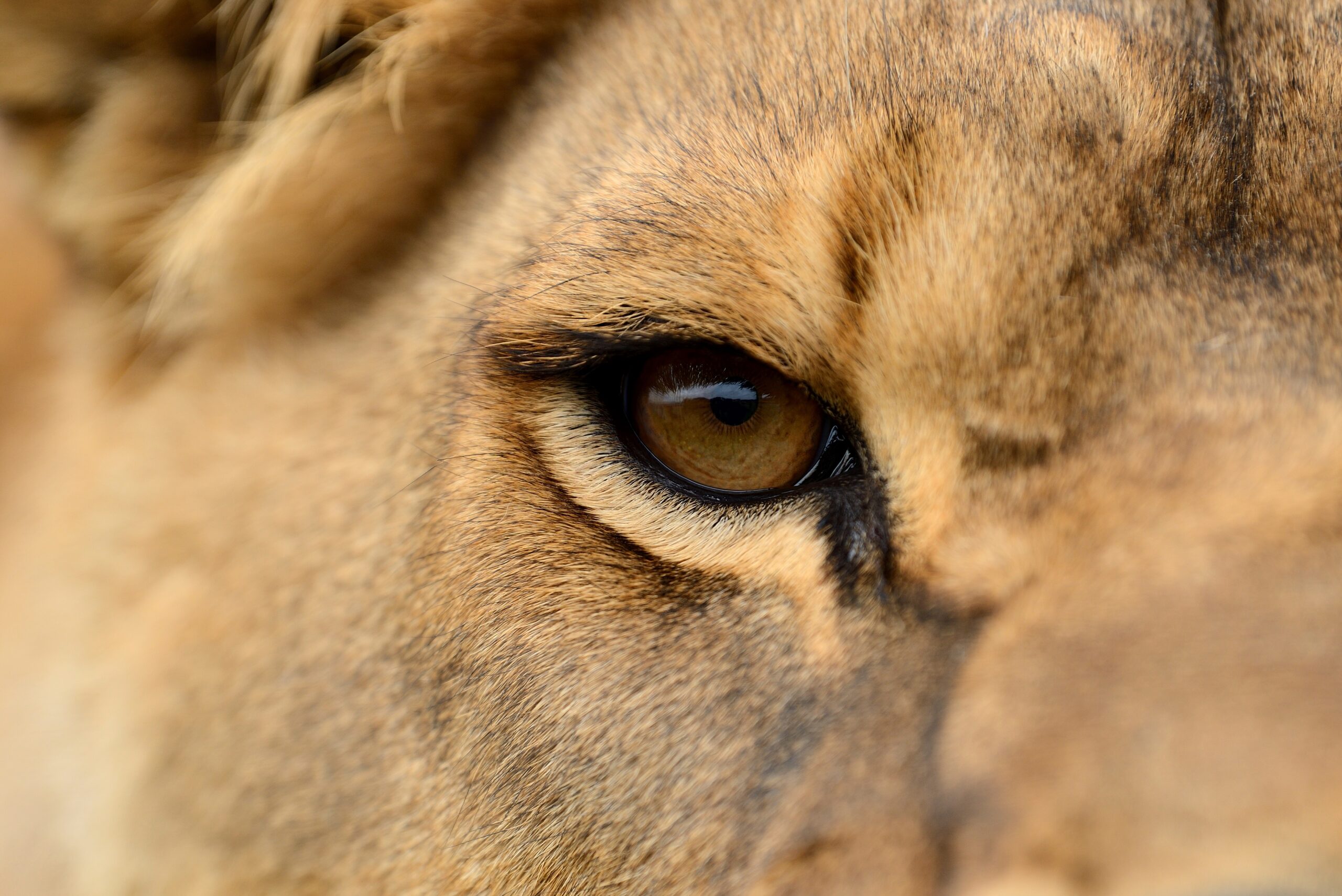This page may contain affiliate links.
Read our disclosure and privacy policy here.
All living things have to co-exist on our planet. Sometimes they are enemies, like lions and zebras, and sometimes, they are friends, like bees and flowers. Sometimes… it’s complicated! Just like your relationship with your siblings or your friends, you’ll find that the interactions between living things on our planet can be very diverse. That means that there are a lot of different ways in which living things interact with each other.
Join us on this exciting adventure as we dive into different types of relationships, from the thrilling chase between predator and prey to the harmonious partnerships of friendly cooperation. So, grab your explorer’s hat and let’s uncover the secrets of the complex web of relationships found in nature!
Table of Contents
The Fascinating Interactions Between Living Things
Main Types Of Interactions Between Living Things
In ecosystems, all living things are connected to each other in some way. Even if they just ignore each other completely, it still counts as a kind of interaction. Scientists study these relationships by looking at how two organisms interact and whether it helps (usually indicated by a ‘+’ sign), harms (usually indicated by a ‘-‘ sign), or has no effect (usually indicated by a zero ‘0’) on either of them. The word ‘fitness’ is a term used by scientists to describe how well an animal or plant fits into its environment and its chance to reproduce. The fitness of an organism often depends on how it interacts with other living things in its ecosystem.
Just like how a puzzle piece fits perfectly into its spot, animals and plants that are ‘ecologically fit’ are well-suited for their surroundings and can survive and thrive there. For example, wolves are really fit for the cold forests of Alaska but would not survive in the heat of the African Savannah or in the humid Amazon Forest.

Did You Know?
Did You Know?
Download Printables
An Underground Network
The mushrooms you see growing near trees and on rotting logs are actually just the fruit of a vast network of thin underground branch-like threads called mycelium. Mycelium can spread out across large distances, and wrap itself around the roots of trees. This entire branching system is referred to as the mycorrhizal network, and it connects individual plants and trees together. Incredibly, tress and plants can share nutrients and water through the mychorrhizal network! Small young trees, called saplings, are often unable to get a lot of direct sunlight needed to survive, and actually rely on nutrient help provided by older more established trees through this network.
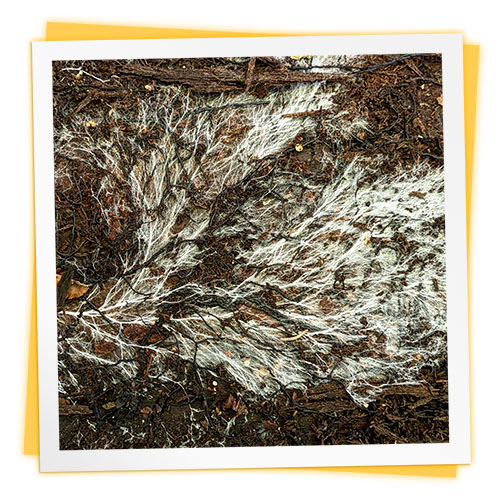
When two organisms interact, whether they are both fungi, or one is a plant and one is an animal, or any other interaction you can think of, they have an effect on each other’s fitness. There are six main types of interaction between living things, and six possible results of their interaction, depending on how they are affected:
- Competition (-/-): Both individuals suffer from the interaction.
- Antagonism (+/-): One individual is hurt, and the other benefits.
- Commensalism (+/0): One individual is unaffected, and the other benefits.
- Amensalism (0/-): One individual is unaffected, and the other is hurt.
- Mutualism (+/+): Both individuals benefit from the interaction.
- Neutralism (0/0): Both individuals are unaffected by the interaction.
By studying these interactions, scientists can learn how different organisms depend on each other and how their actions can affect the balance of an ecosystem. Here’s how each of these types of interactions between living things work.
Competition: You want to fight?
When two organisms compete, they both have a strong desire to get what they need to survive, and usually it’s the same thing! It’s like a race to gather the resources necessary to live. Competition can be tough and comes with a lot of risks. They might have to use up a lot of their energy, put themselves in danger, or even attract attention from predators while trying to win the competition. It’s like when both you and your friend see the last delicious piece of broccoli in the salad and you both want it so much… no? Ok maybe then the the last pickle in the pickle jar? Well picture something you really want, and someone else wants it too. What would you do to get it? That’s competition.
In nature, competition can happen between animals of the same species or animals of different species. They may have to compete for important things like food, space to live, or even a mate to have babies with. The ones that are better suited to their environment or have special abilities are more likely to win the competition. They have qualities or skills that give them an advantage in some situations but not in others, just you might be really good at math, but have difficulty playing the piano. Because the challenges we face in nature are often unpredictable, various species of organisms will try to come up with different strategies that are best suited to them.
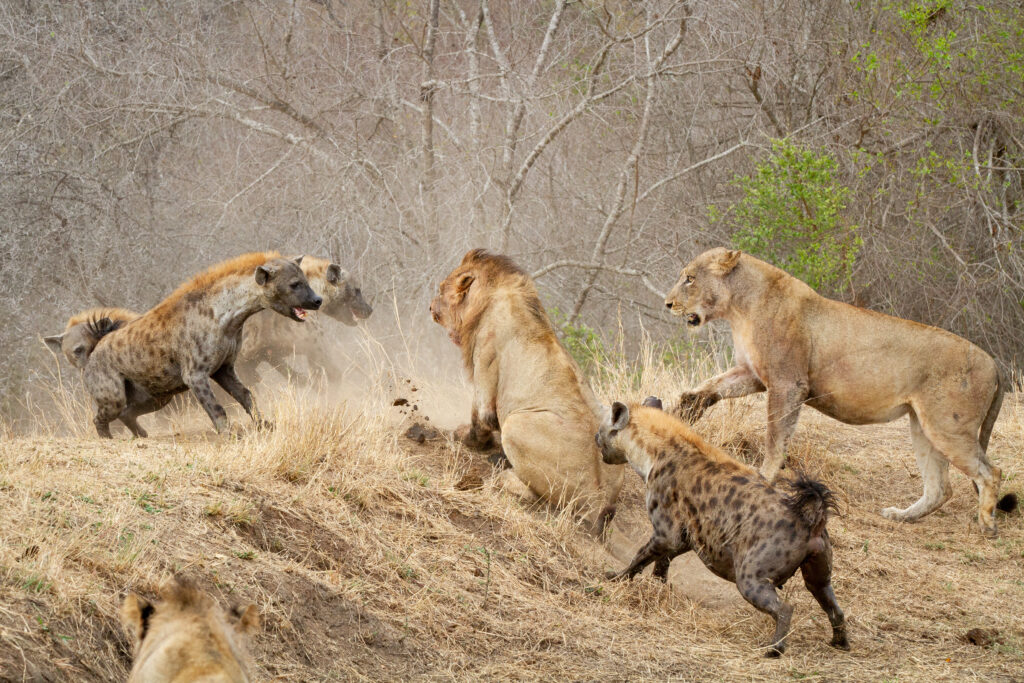
Lions and hyenas are an example of Interspecific Competition.
There are two main types of competition in nature. Interspecific competition is when different species compete against each other for resources like food that they both need to survive. For example, lions and hyenas compete against each other for prey.
The second type is called intraspecific competition. This type of competition happens when members of the same species competes for limited resources. For example, when two robins directly compete against each other for the best nesting site. Or when 2 little humans compete against each other for the best spot on the couch… sound familiar? Or even when two ladybugs compete against each other for aphids on a flower.
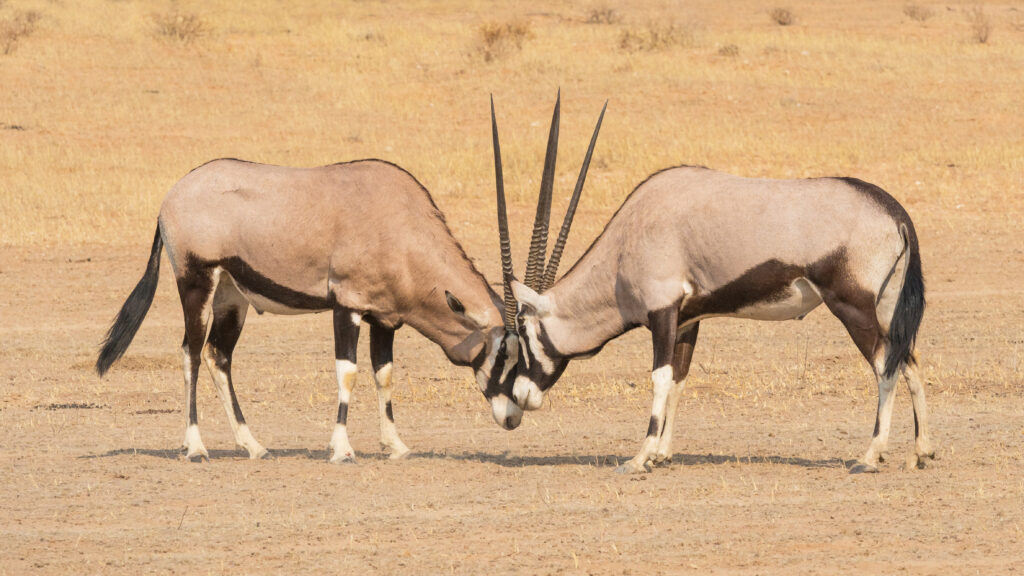
A couple of gemsbok fighting for dominance. A gemsbok is a type of antelope from South Africa. This is an example of intraspecific (same species) competition.
Check out this article where we go into more detail about competition between living things.
Amensalism: Sorry - not sorry!
Amensalism is when one organism doesn’t really get affected by or notice the interaction, but the other organism is harmed. In amensalism, one organism causes harm or makes life difficult for another organism without any obvious benefit or harm to itself. There are two types of amensalism: direct, and indirect.
In direct amensalism, one organism physically prevents or hinders another organism’s survival. For example, imagine you are taking a walk and accidentally step on an ant. It doesn’t really affect you, but it can harm the ant and make its life difficult or even cause it to die.
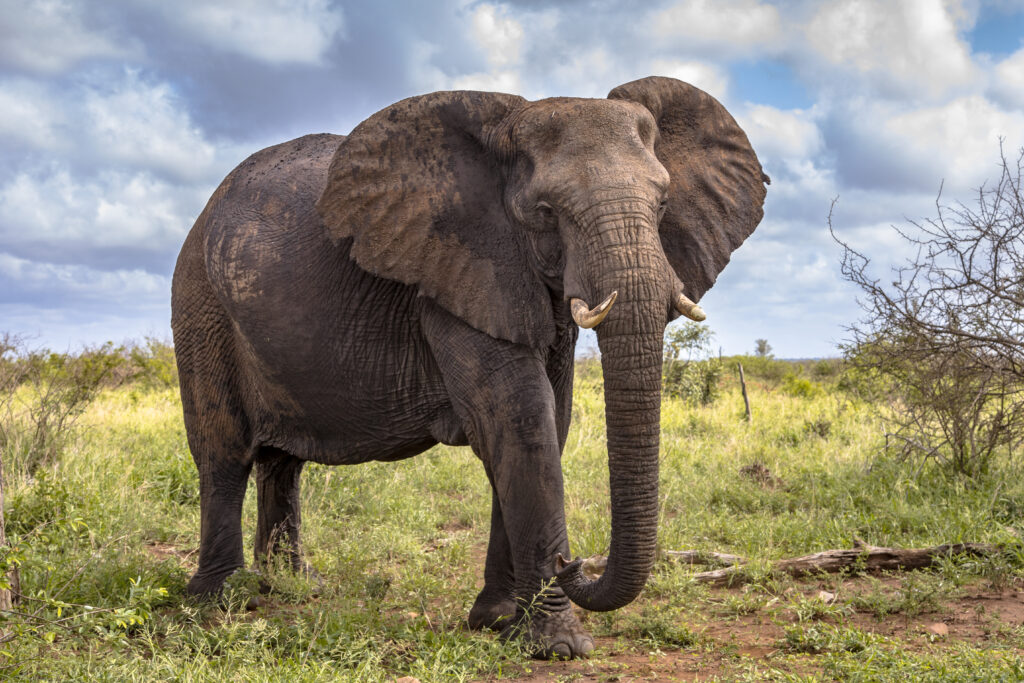
This bull elephant is trampling grass and small plants when walking through them. He does not mean to harm the grass, nor does he benefit from harming it. The relationship between the elephant and the grass is an example of direct amensalism.
In indirect amensalism, an organism unintentionally harms another organism through chemical substances or waste. For example, some plants release certain chemicals into the soil in a process called allelopathy. These chemicals, called inhibitors, can make it difficult for a nearby species of fungi to grow. Those fungi do not harm the plant in any way, so inhibiting the fungi (preventing them from growing) is probably accidental. The plant is not intending to harm the fungus, and the fungus does not harm the plant at all. This accidental harm which is of no benefit to the plant is called indirect amensalism.
[Warning: Dad joke ahead] Another example might be if you did not shower in a long time, and you started to smell really bad. Maybe so bad that people around you started feeling a little sick when they smelled you! These people were not really hurting you, and you did not mean to make them sick, but the end result is that you smell and they feel sick. So the lesson here is… go take a shower!
Antagonism: Take that!
Antagonism is a type of relationship where one individual benefits while the other is harmed. It’s like a one-sided interaction where one organism gains an advantage, but at the expense of another organism. There are a variety of different types of antagonism in nature.
Predation occurs when one animal hunts, captures, and consumes another animal. A lion hunting, capturing, and eating a gazelle would be considered predation.
Grazing occurs when animals known as grazers feed on vegetation. This is like when cows eat grass, for example. Grazing primarily involves grasses and small plants.
Browsing is similar to grazing, but is focused on plants with woody stems, like trees and shrubs. Giraffes, for example would be considered browsers as they consume the leaves of trees like acacia, mimosa, and wild apricot.
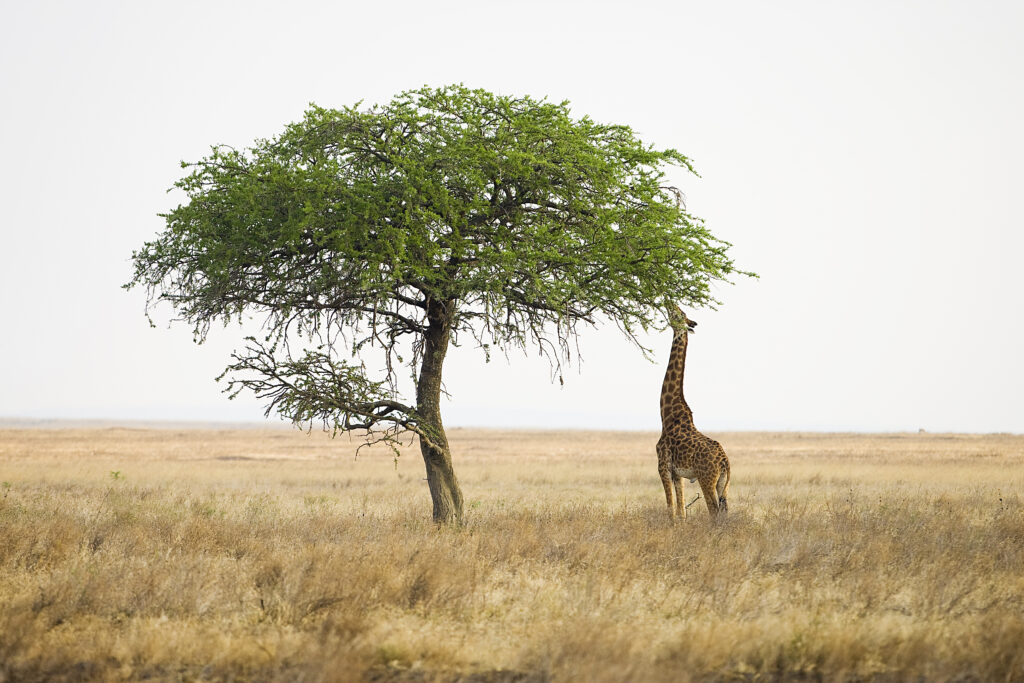
A giraffe eats leaves from a tree. This is an example of browsing, which is considered an antagonistic interaction. The giraffe benefits, while portions of the tree are consumed.
Parasitism is a type of antagonism where one organism, called the parasite, lives in or on another organism, called the host. The parasite relies on the host for food and shelter, often causing harm to the host. Parasites can be internal, like bacteria and viruses, or external like ticks and fleas. They usually feed on the host, weakening it. But not all parasitic relationships are immediately harmful to the host. You can learn more about parasitism in our more detailed article on antagonistic interactions in nature.
Allelopathy happens when certain plants release chemicals into the environment which prevent other plants from growing near them. Knowing this is extremely important for gardeners. The black walnut tree, for example, is known to produce chemicals that prevent other trees and shrubs from growing nearby. You might have noticed that this is kind of similar to indirect amensalism described above (remember, the one where you don’t shower and get smelly?). The main difference here is whether or not you benefit from the harm caused to others.
Basically, the question is, are you doing it on purpose and for a benefit? Is the plant or tree purposely trying to prevent other plants from growing nearby to help itself, or is it accidental? If it’s accidental and there is no benefit, then it is considered indirect amensalism. If it’s on purpose and there is a benefit, then it’s antagonism. You can learn more about these details in our article on competition between living things.
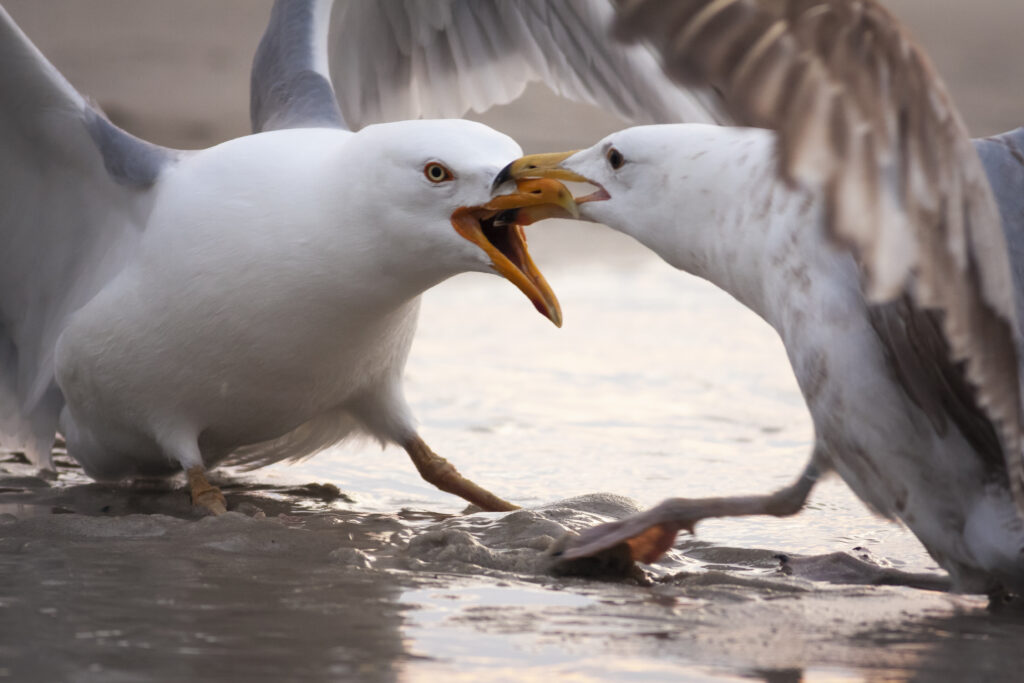
One seagull is defending its territory from another seagull. This direct confrontation over territory is called interference competition.
Exploitative competition happens when two species compete for the same limited resource without actually confronting each other. Two species of bird, for example, may compete for the same limited food source, like a specific insect or seed. While the two species do not ever get into any direct confrontation, one of the species of bird may be more successful at getting the insect, reducing it’s availability for the other species. This would cause the other species to be disadvantaged and suffer as a result.
Interference competition happens when one organism actively prevents another from accessing a resource, interfering with the other organism’s ability to survive. Territory marking and defending is one example of interference competition, when a specific territory is marked and defended by one individual, preventing another individual from access to that area for a resource they need. So let’s say you had a treehouse, and you kept all the candy in your treehouse. Your friends want some candy, but you don’t allow them into the treehouse, so they can’t get it. That would be called interference competition. You are interfering with their ability to get to the candy. It may not be a nice thing to do, but there’s not a lot of candy! It’s a limited resource.
Neutralism: What was your name again?
In a neutral interaction, both organisms go about their lives without being influenced by each other. They may occupy the same habitat or share the same resources, but their presence doesn’t have a noticeable effect on one another. It’s like playing in the park with other kids. You are aware of other kids there, but you might just be focused on what you are doing. You’re not bothered by them, nor are they bothered by you.
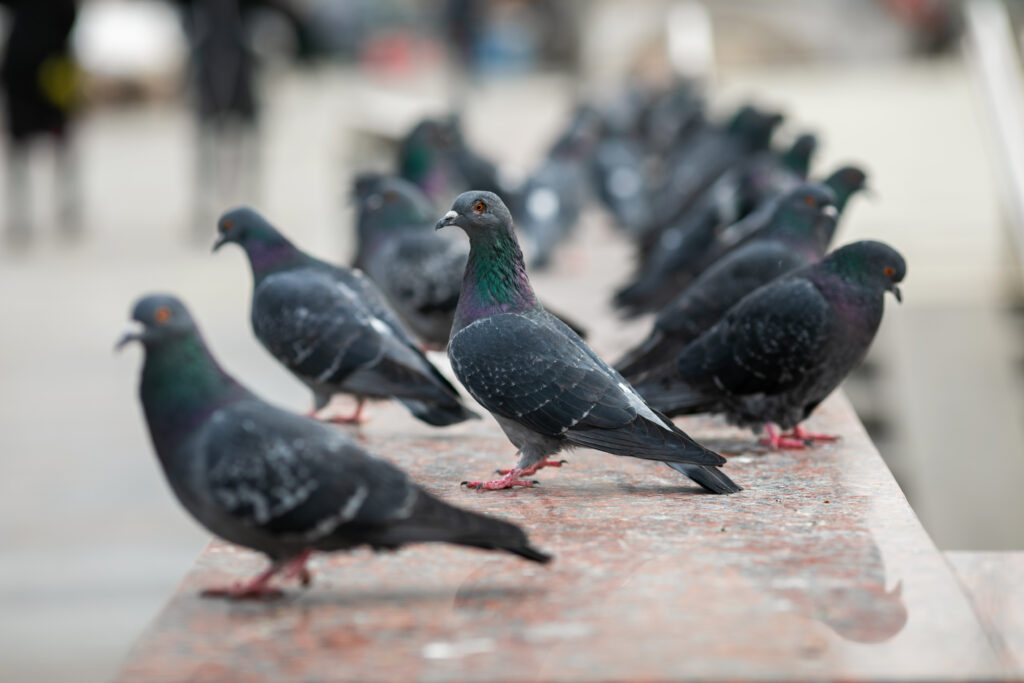
One example of Neutralism is the relationship between humans and pigeons. The occupy many of the same places humans do, but they don’t seem to mind us and we don’t seem to mind them… except maybe for the poop!
Neutralism is an interesting concept because it shows that not all relationships in nature have to be competitive or cooperative. Sometimes, organisms can live side by side without any real interaction. But it’s important to know that this is pretty rare, and very few organisms are neutral to each other all of the time. Sometimes they might not interact directly but still benefit or harm each other, such as by changing the environment. For example, trees in the Amazonian rainforest and algae in the ocean all help maintain the world’s climate, so they benefit almost every animal, despite not being anywhere near them to interact directly.
Commensalism: You're welcome!
In this type of relationship, one organism gets all the benefits while the other is not affected at all. It’s like having a brother or sister who walks around dropping candy from their pockets. They don’t even realize it. And you just keep grabbing the candy and eating it! That’s really a delicious situation for you, but they don’t even notice. That’s commensalism.
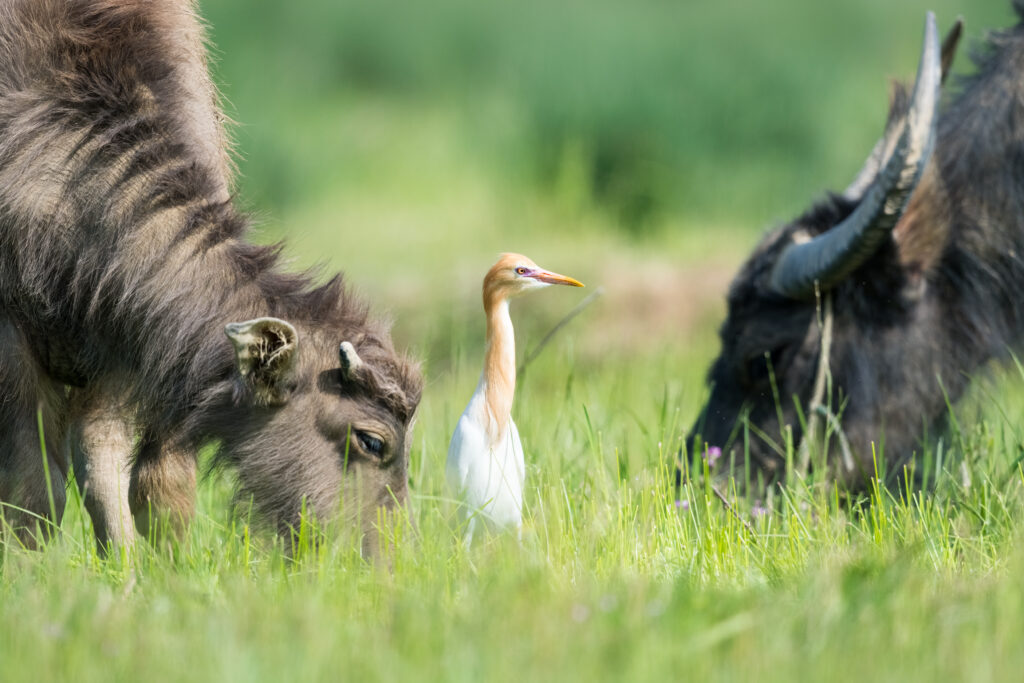
The relationship between cattle egrets and cattle is a good example of commensalism, since cattle egrets benefit from the relationship while the cattle themselves are completely unaffected.
Let’s imagine a real-life example: the relationship between cattle egrets and grazing cattle. Cattle egrets are birds that love to eat insects. When cattle graze in the fields, they stir up insects from the grass. This creates a buffet of tasty bugs for the cattle egrets to feast on. The birds happily hop around the cattle, snatching up the insects without bothering the cattle in any way. The cattle continue grazing, completely oblivious to the presence of these lucky birds.

Did You Know?
Did You Know?
Download Printables
Honey Dew... Poop!
One of the most accessible mutualistic relationships to observe in nature is the relationship between some ants and aphids. Aphids secrete a substance from their abdomen called ‘honey dew’ when they are feeding on plant sap. Let’s be clear. That’s just a more interesting way to say ‘aphid poop’. Ants love it because it’s high in sugar, which they need for energy. Ants find ‘honey dew’ to be such a convenient and easy way to get their sugar fix that they will actually defend the aphids from other predators like wasps or ladybugs, in order to make sure the aphids can continue to poop out this delicious substance.
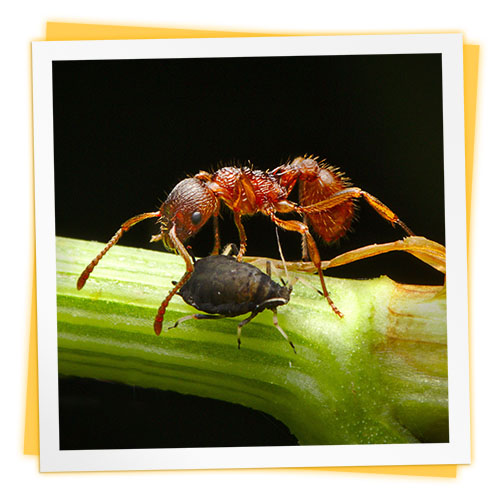
Mutualism: Thank you! No, Thank YOU!
Mutualism is like having a win-win partnership, where both organisms involved benefit from each other’s help. It’s like being part of a team where everyone works together and both sides come out on top.
One amazing but familiar example of mutualism is the relationship between bees and flowers. Bees need nectar from flowers as a source of food, so they visit flowers to collect it. As they move from flower to flower, they unintentionally transfer pollen, which is like magic dust that helps flowers reproduce. The flowers benefit from this because they need pollen to create seeds and grow new plants. So, bees get their yummy nectar, and flowers get the help they need to make more flowers. It’s a fantastic teamwork where both bees and flowers win!
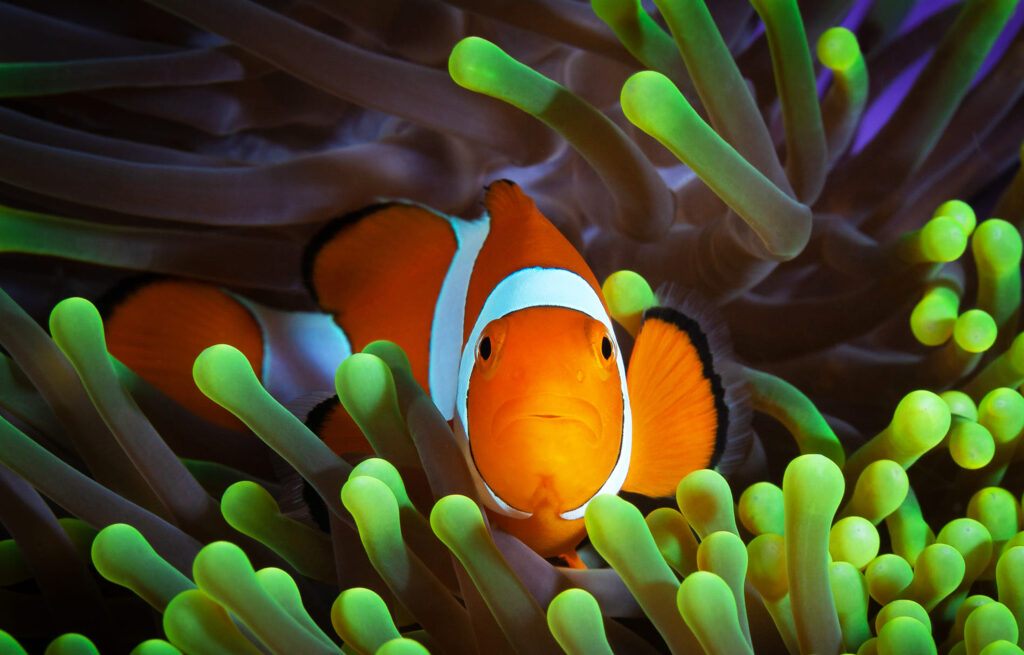
Remember Finding Nemo? Clownfish and anemones have a mutualistic (and colorful!) relationship. The clownfish keeps the anemone clean and brings it food, while the anemone protects the clownfish from predators with its stingers.
Another fascinating mutualistic partnership can be seen between clownfish and sea anemones. Clownfish live among the stinging tentacles of sea anemones, which provide them with protection from predators. The clownfish have a special layer of mucus on their skin that makes them immune to the anemone’s sting. In return, the clownfish keep the anemone clean by eating parasites and dead skin cells. They also bring food to the anemone by leaving behind small bits of leftover meals. It’s a perfect arrangement—the clownfish get a safe home, and the anemone gets food and cleaning services.
In mutualism, both organisms benefit from the relationship. It’s like being part of a fantastic team where everyone helps each other and comes out as winners. Nature is filled with these amazing partnerships, showing us that when organisms work together, incredible things can happen. Mutualism reminds us that cooperation and teamwork can lead to success and harmony in the natural world, not just competition and struggling.
Interactions Between Living Things: Summary & Review
In this article we learned that there are 6 different types of interactions between living things in nature: Competition, Antagonism, Commensalism, Amensalism, Mutualism, and Neutralism. Each of these kinds of interactions has winners, losers, and those unaffected by the interaction. The winners are the organisms that benefit from the interaction, and the losers are organisms that suffer from the interaction. The ones that are unaffected are usually not even aware of the interaction at all!
All these interactions can take place between members of different speciesm like lions and antelopes, or members of the same species, like you and your friend. Even when both organisms that are interacting are completely unaffected, it still counts as an interaction: Neutralism. The only interaction with positive results for everyone involved is Mutualism. Everyone LOVES mutualism, where everyone gets along, everyone helps each other and is happy, and, like in the Lego movie, everything is awesome!
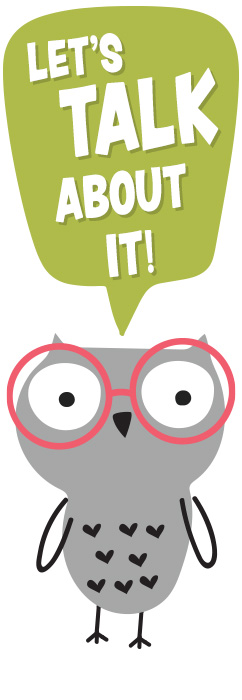
DISCUSSION
DISCUSSION
DISCUSSION
FOLLOW-UP TOPICS
Science Topics
Natural Interactions
We learned about the six principal types of interactions between living things in nature. See if your child / students are able to come up with one or two examples of each type of interaction. Now as a challenge, see if they can come up with a single organism that has interactions that fall into as many of the categories discussed as possible: Competition, Antagonism, Commensalism, Amensalism, Mutualism, and Neutralism.
Neutralism
Is it possible for an interaction in nature to be truly neutral? In our example, we discussed how humans and pigeons have a neutral relationship. They don’t mind us, we don’t mind them. But is the relationships actually neutral? Why are pigeons not afraid of humans?
Competition and adaptation
When adaptation and evolution is discussed, we sometimes refer to change taking thousands of years. But there are adaptations occurring all around us, all the time.
Humans have taken control over some of these adaptation. For example, in some neighborhood, humans compete with animals for space. Coyotes will venture into towns looking for food. Humans will capture and euthanize any coyotes that seem unafraid of entering towns, because we want to prevent that coyote from producing offspring that will have the same lack of fear of humans. Humans take control to force an adaptation in coyotes.
What other adaptations do humans try to control? What other adaptations in organisms occur around us that are the unintentional result of human activity?
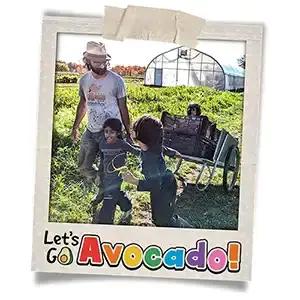
There’s a lot to explore right where we are, in our own neighborhoods and backyards! Join us while we get off the couch and explore the everyday wonders of nature, science, space, engineering, art, and anything else we stumble upon during on our adventures.


